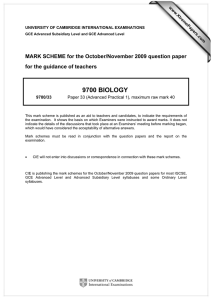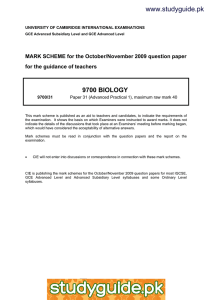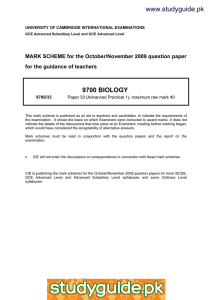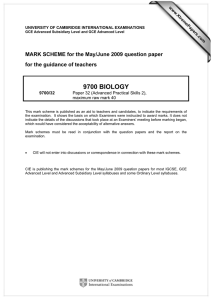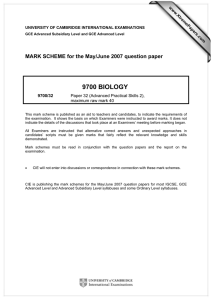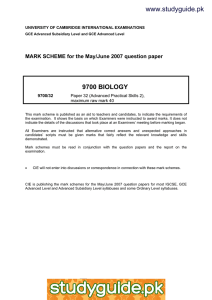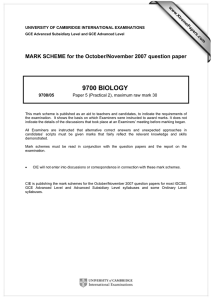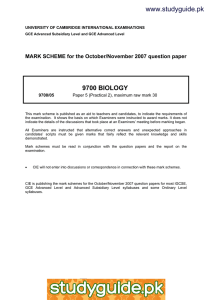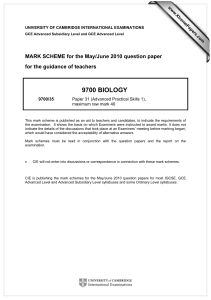9700 BIOLOGY MARK SCHEME for the October/November 2009 question paper
advertisement
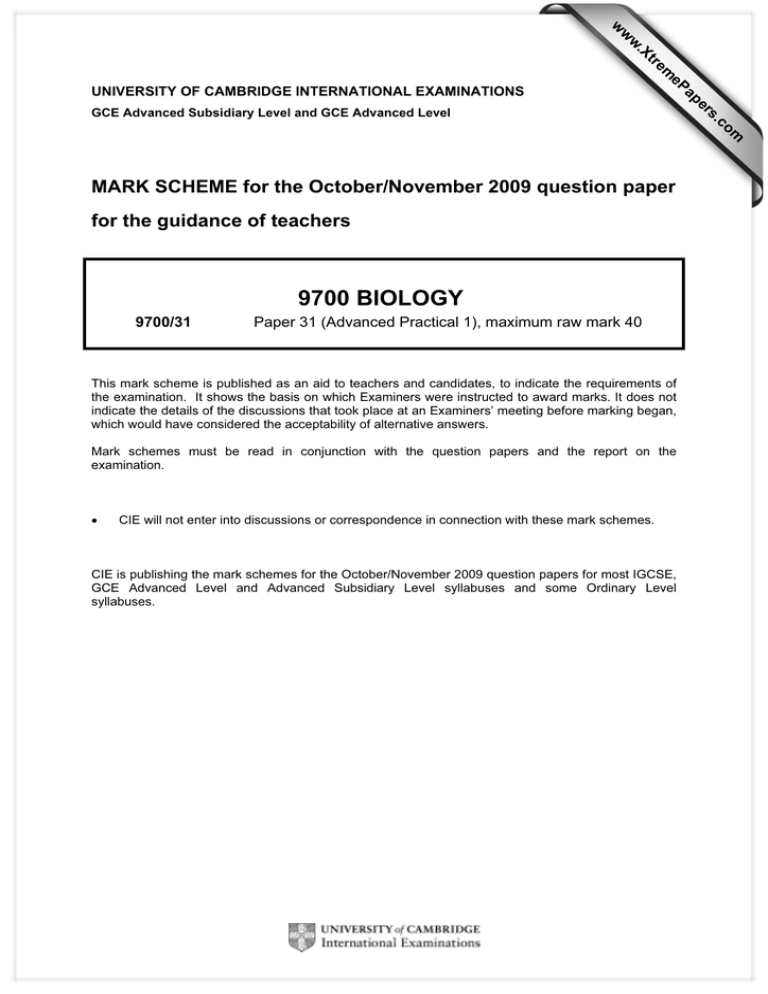
w w ap eP m e tr .X w UNIVERSITY OF CAMBRIDGE INTERNATIONAL EXAMINATIONS for the guidance of teachers 9700 BIOLOGY 9700/31 Paper 31 (Advanced Practical 1), maximum raw mark 40 This mark scheme is published as an aid to teachers and candidates, to indicate the requirements of the examination. It shows the basis on which Examiners were instructed to award marks. It does not indicate the details of the discussions that took place at an Examiners’ meeting before marking began, which would have considered the acceptability of alternative answers. Mark schemes must be read in conjunction with the question papers and the report on the examination. • CIE will not enter into discussions or correspondence in connection with these mark schemes. CIE is publishing the mark schemes for the October/November 2009 question papers for most IGCSE, GCE Advanced Level and Advanced Subsidiary Level syllabuses and some Ordinary Level syllabuses. om .c MARK SCHEME for the October/November 2009 question paper s er GCE Advanced Subsidiary Level and GCE Advanced Level Page 2 Mark Scheme: Teachers’ version GCE A/AS LEVEL – October/November 2009 Question Expected Answers 1 (a) (i) Prepare the space below to record all your results. PDO recording all cells drawn AND (heading top or to left) 2 W, X, Y, AND Z; Ignore P MMO MMO MMO collection 3 decisions 1 Syllabus 9700 Marks Paper 31 Additional Guidance [1] If W, X, Y, Z NOT given. Allow concentration. (heading top or to right) time; [1] Ignore units. Reject units in table. times recorded for samples W, X, Y and Z; [1] Ignore wrong recording 1:20 etc. Ignore P. time at W/5.00 quicker/less than time for Z/0.25; [1] Reject if 1.24 etc. unless have made it clear this is minutes and seconds 1 minute 24 seconds. time for P between 0.25/Z and 1.00/Y; Allow same as Z or Y. [1] Allow 1.24 etc. as long as figures between Z and Y. whole number of seconds recorded (units must be clear somewhere); [1] (ii) Use your results to estimate the concentration of sugar in P. decisions is W or X or Y or Z 2 [1] OR is between W and X or X and Y or Y and Z correct from results Allow candidate P result equal to or more than W or equal to or less than Z If no reading for P then can only award correct units. Reject g/100 cm–3 Ignore incorrect units. OR units g 100 cm–3 or g/100 cm3; is 5.00 or 2.50 or 1.00 or 0.25; OR (P) is between 5.00 and 2.50 or 2.50 and 1.00 or 1.00 and 0.25; © UCLES 2009 [1] Do not allow any estimate between two values. Page 3 Mark Scheme: Teachers’ version GCE A/AS LEVEL – October/November 2009 Question Expected Answers (b) State degree of uncertainty in using the small syringe to measure the volumes. ACE interpretation +/– AND half volume given AND units/cm3/ml/cc; Syllabus 9700 Marks (c) (i) Identify a significant source of error in estimating the sugar concentration of P. interpretation determination of colour change; Reject temperature of water-bath. 1 Ignore timing. P between two concentrations/not enough concentrations; ACE (ii) Suggest how you would improve the investigation. improvements more/different/wider range concentrations; Additional Guidance [1] 1 ACE Paper 31 [max 1] Reject correcting an error e.g. use a colorimeter. Allow P not tested for other sugars. [1] 3 three examples of concentrations/serial dilution;; [2] Ignore units. white card to show colour change; [1] Reject colorimeter/colour chart. (repeat/replicate) more than once/many/more times/twice/thrice; [1] Reject repeat/repeat again/repeat(s) experiment. mean/average; [1] test P before hydrolysing; [1] have equal or excess volume of Benedict’s; © UCLES 2009 [max 3] Page 4 Mark Scheme: Teachers’ version GCE A/AS LEVEL – October/November 2009 Syllabus 9700 Question Expected Answers Marks (d) Suggest one reason why the concentration of sugar in the phloem is not always the same. ACE conclusion different part of plant/near source or sink/position in phloem; Paper 31 Additional Guidance 1 different plant; different time day/year or different season; higher temperature; different student so different timing to colour change; AVP; aphids feeding ref to osmosis/water relations needs link to sugars ref to damage to plant Total Reject any other errors e.g. ref. to volumes. [max 1] [14] © UCLES 2009 Page 5 Mark Scheme: Teachers’ version GCE A/AS LEVEL – October/November 2009 Syllabus 9700 Paper 31 Question Expected Answers Marks Additional Guidance Fig 2.1 2 (a) Draw a large, labelled plan diagram of the part of the stem shown in fig. 2.1. Add TWO annotations to describe the visible appearance of two tissues. PDO layout AND longer than 6 cm from centre of [1] clear, sharp, AND no shading 1 drawn corner in both directions; unbroken lines MMO collection 2 no cells AND only correct quarter drawn; [1] [1] epidermis as two lines maximum 3 mm at the corner OR corner region of collenchyma drawn; Must be a discrete area. PDO recording 1 MMO decision 2 AND smaller V.B. corner vascular bundle outer and OR half on right side; inner edges both curved towards corner any one correct label/epidermis/trichome/cortex/vascular bundle/xylem/phloem/ pith; Annotations based on colour walls colour/lumen xylem phloem red/pink white/ hollow green size cells Allow tightly packed shape of tissue/cells walls thick cortex pith epidermis collenchyma large large small/ thin small 2 layers square compact angular/pentagon/ AW thin thin © UCLES 2009 thick [1] [1] [max 1] Must be two different tissues. Allow for any correct description of visible feature. Ignore functions. Page 6 Mark Scheme: Teachers’ version GCE A/AS LEVEL – October/November 2009 Syllabus 9700 pith large cells, thin walls epidermis cortex xylem stained red phloem small, tightly packed cells © UCLES 2009 Paper 31 Page 7 Mark Scheme: Teachers’ version GCE A/AS LEVEL – October/November 2009 Syllabus 9700 Paper 31 Question Expected Answers Marks Fig. 2.2 (b) Make a large drawing of cell X and all the cells that are touching it. Label cell X on your drawing. PDO layout [1] cell X largest internal no shading AND clear, sharp, AND 1 dimension is more than unbroken lines 3cm; Additional Guidance Ignore additional cells beyond cell X plus surrounding cells MMO collection 2 labelled correct cell X; [1] drawn all cells (complete) surrounding (cell X); [1] Ignore incorrect labelling of X/no label and number of cells, must have cells all round cell X but ignore additional cells/textbook additions. PDO recording 1 MMO decision 2 cell X (cell X) three adjoining straight walls; [1] Ignore incorrect labelling of cell X. (must have at least minimum 4 adjacent cells) [1] all cells drawn must have side walls touching; Reject if cell wall boundaries are not clear. cell between 6 o’clock and 9 o’clock has longer side attached to cell X than opposite wall; [1] OR anomaly on right separated as line from adjacent cells; Total [12] © UCLES 2009 Ignore any additional cells and organelles or textbook drawings. Page 8 Mark Scheme: Teachers’ version GCE A/AS LEVEL – October/November 2009 Question Expected Answers 3 (a) (i) Prepare the space below and record your observations. MMO collection records observations of cells/yeast/AW grains/bubbles/spots for A1 1 and A2 and A3; Allow stained/blue unstained white/colourless/clear Ignore solution/liquid Reject molecules MMO decision 1 (boiled yeast/A1) Syllabus 9700 Marks Paper 31 Additional Guidance [1] Allow drawings under headings. Ignore other colours than blue or /white/colourless. [1] A1 boiled (mostly) blue/stained/no white (white) A2 high concentration salt AND (yeast in glucose/A3) (mostly) white/unstained (blue) A3 in glucose/living AND (yeast in salt/A2) white/unstained//white and blue/blue; ACE (ii) Explain the appearance of the yeast cells in A1 (boiled) and A3 (living) interpretation (boiled yeast/A1 blue/stained cells ) 1 [1] AND Reject yeast denatured. cells dead/no activity/denatured enzymes/AW (b) PDO AND (yeast in glucose/A3 white/unstained) living cells/example e.g. budding/respiration/enzymes active; ECF from results. (i) Complete Table 3.1 by calculating the missing value for the mean activity of yeast. Show all the steps in your calculation. display [1] shows 177+180+168 and divided by 3; 2 177/3 180/3 168/3 then adding up; then by 3 again; ECF from point 1, allow answer from point 1 divided by 3 or 9. © UCLES 2009 [1] 177+180+168 divides by 9;; 177+180+168 = 525/9 = 175/3 = (58);; Page 9 PDO Mark Scheme: Teachers’ version GCE A/AS LEVEL – October/November 2009 Question Expected Answers (ii) Plot a graph of these data shown in Table 3.1. layout y-axis bubbles min–1 or /min; O x-axis concentration/conc/ 4 %/percentage AND Syllabus 9700 Marks Paper 31 Additional Guidance [1] [1] Allow 10 on origin on y but must be labelled. P plotting crosses or dot in circle ONLY AND plots correct; [1] Do not credit blobs in or out of circles. Credit x s in circles. L [1] Do not credit if any extrapolation beyond 0 or 5.0 S scale as 1.0 to 2 cm (allow no 0) and 20 to 2 cm; ECF from wrong O – must use more than half grid for both x and y axis with sensible scale 20 to 2cm and y 2 to 2 cm. ruled/straight line to all points; Smooth curve through all points. © UCLES 2009 Page 10 Question Mark Scheme: Teachers’ version GCE A/AS LEVEL – October/November 2009 Expected Answers Syllabus 9700 Marks Paper 31 Additional Guidance (iii) Describe the results shown in your graph. ACE interpretations 2 increases/most bubbles to 1.5%; [1] decreases/AW; [1] (iv) From your graph estimate the mean activity of yeast in a 2.0% sodium chloride solution. ACE interpretaton 1 correct reading from graph at 2.0% AND bubbles per minute/min–1; [1] Whole number of bubbles only. [1] Allow ref. increase in process e.g. active transport. [1] Reject yeast denatured/killed/dies. Enzyme killed. Enzyme doesn’t work. (v) Explain the difference in the activity between ACE conclusion 2 (0.0% to 1.5%) sodium chloride solution (Salt) increase enzyme (3.0 to 5.0%) sodium chloride solution (Salt) inhibits/denatures enzymes OR causes water to move out of cells/ osmosis/dehydration/dessication of cells/plasmolysed; activity /AW Total [14] © UCLES 2009
